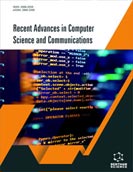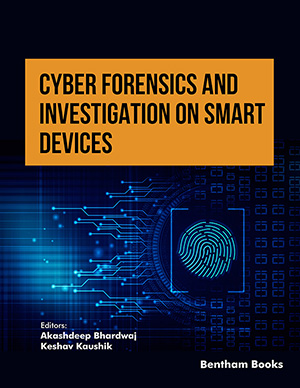
Abstract
Background: Intelligent reflecting surfaces (IRS) have evolved as one of the key technologies by enabling reconfigurable, intelligent, and low-power solutions for sixth-generation (6G) wireless communication.
Objective: The objective of this paper is to improve outage performance by deploying the IRS Module.
Method: In this research, an IRS-assisted NOMA network is explored over η - μ fading channel, where the IRS is placed on top of the base station (BS). IRS aids in fine-tuning the phase of incoming signals from BS in a meticulous way, which improves the performance of the system. The statistical channel modelling of the downlink IRS-NOMA system is proposed and validated with Monte Carlo (MC) simulation. Also, analytical expressions of OP are derived for k!! user in the IRS-NOMA system over η - μ fading channel.
Result: Furthermore, the influence of performance factors, such as the number of reflecting elements (M) on OP, is examined.
Conclusion: Simulation results reveal that the IRS-NOMA system experiences less outage compared to IRS-OMA and conventional relaying techniques.
Keywords: Intelligent reflecting surfaces (IRS), η - μ fading channel, outage probability (OP), non-orthogonal multiple access, channel modelling, IRS-NOMA.
International Journal of Sensors, Wireless Communications and Control
Title:Outage Analysis of IRS-NOMA System over η - μ Fading Channel
Volume: 15 Issue: 1
Author(s): K. Srinivasarao*, V. Venkata rao and Priyank Sharma
Affiliation:
- Department of Electronics and Communication Engineering, Narasaraopeta Engineering College (Autonomous), Narasaraopeta, India
Keywords: Intelligent reflecting surfaces (IRS), η - μ fading channel, outage probability (OP), non-orthogonal multiple access, channel modelling, IRS-NOMA.
Abstract:
Background: Intelligent reflecting surfaces (IRS) have evolved as one of the key technologies by enabling reconfigurable, intelligent, and low-power solutions for sixth-generation (6G) wireless communication.
Objective: The objective of this paper is to improve outage performance by deploying the IRS Module.
Method: In this research, an IRS-assisted NOMA network is explored over η - μ fading channel, where the IRS is placed on top of the base station (BS). IRS aids in fine-tuning the phase of incoming signals from BS in a meticulous way, which improves the performance of the system. The statistical channel modelling of the downlink IRS-NOMA system is proposed and validated with Monte Carlo (MC) simulation. Also, analytical expressions of OP are derived for k!! user in the IRS-NOMA system over η - μ fading channel.
Result: Furthermore, the influence of performance factors, such as the number of reflecting elements (M) on OP, is examined.
Conclusion: Simulation results reveal that the IRS-NOMA system experiences less outage compared to IRS-OMA and conventional relaying techniques.
Export Options
About this article
Cite this article as:
Srinivasarao K.*, rao Venkata V. and Sharma Priyank, Outage Analysis of IRS-NOMA System over η - μ Fading Channel, International Journal of Sensors, Wireless Communications and Control 2025; 15 (1) . https://dx.doi.org/10.2174/0122103279312349240710060042
| DOI https://dx.doi.org/10.2174/0122103279312349240710060042 |
Print ISSN 2210-3279 |
| Publisher Name Bentham Science Publisher |
Online ISSN 2210-3287 |
Call for Papers in Thematic Issues
Artificial Intelligence in Next-Generation Wireless Communications: Innovations, Challenges and Applications
This special issue aims to explore the cutting-edge advancements and applications of Artificial Intelligence (AI) in the realm of wireless communications. As wireless networks continue to evolve and become more complex, AI techniques offer promising solutions to enhance network performance, efficiency, and reliability. This issue will focus on novel AI-driven ...read more
CYBER-PHYSICAL SYSTEMS' ADVANCEMENTS IN HIGH-QUALITY SENSING/ACTUATION, VISUALIZATION, AND AMBIENT/HUMAN QUALITY CHECKING
A Cyber-Physical System (CPS) integrates physical and computational components to monitor and control the physical processes seamlessly. This device collection intercommunicates and interacts with the physical world via sensors and actuators in a feedback loop with heavy use of wireless sensor/actuator networks (WSANs) and can leverage the CPS's overall performance, ...read more
Information, Trust, and Risk: Exploring the Intersection of Sensing, Wireless Communications, and Control
Sensing technologies, wireless communications, and control systems are becoming ubiquitous in our daily lives, with the potential to enhance and streamline many aspects of modern society. However, this also creates new challenges in terms of ensuring trust and managing risks associated with the use of these technologies. The sheer volume ...read more
Machine Learning and AI-Enabled Sensor Fusion Techniques for Wireless Communication Systems and Control
This special issue explores the intersection of machine learning, artificial intelligence (AI), sensor fusion techniques, wireless communication systems, and control methodologies. Intelligent systems that can effectively handle and analyze enormous volumes of sensor data in real-time are becoming increasingly necessary as Internet of Things devices and sensor networks proliferate. In ...read more
Related Journals
 1
1
- Author Guidelines
- Graphical Abstracts
- Fabricating and Stating False Information
- Research Misconduct
- Post Publication Discussions and Corrections
- Publishing Ethics and Rectitude
- Increase Visibility of Your Article
- Archiving Policies
- Peer Review Workflow
- Order Your Article Before Print
- Promote Your Article
- Manuscript Transfer Facility
- Editorial Policies
- Allegations from Whistleblowers






















